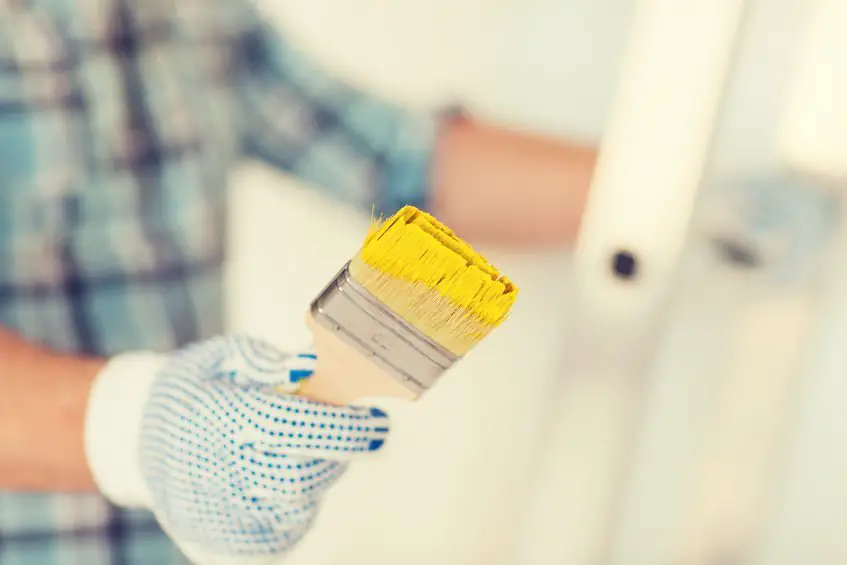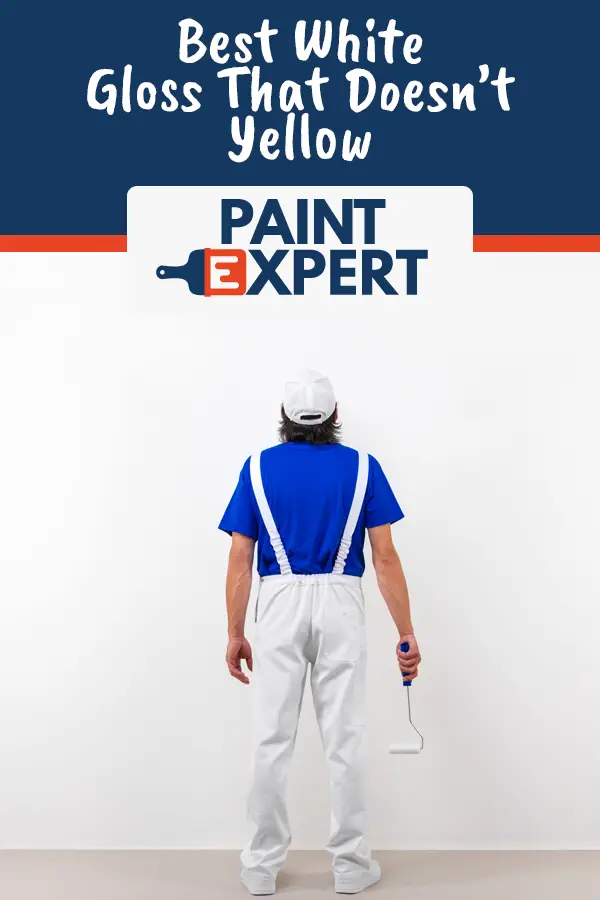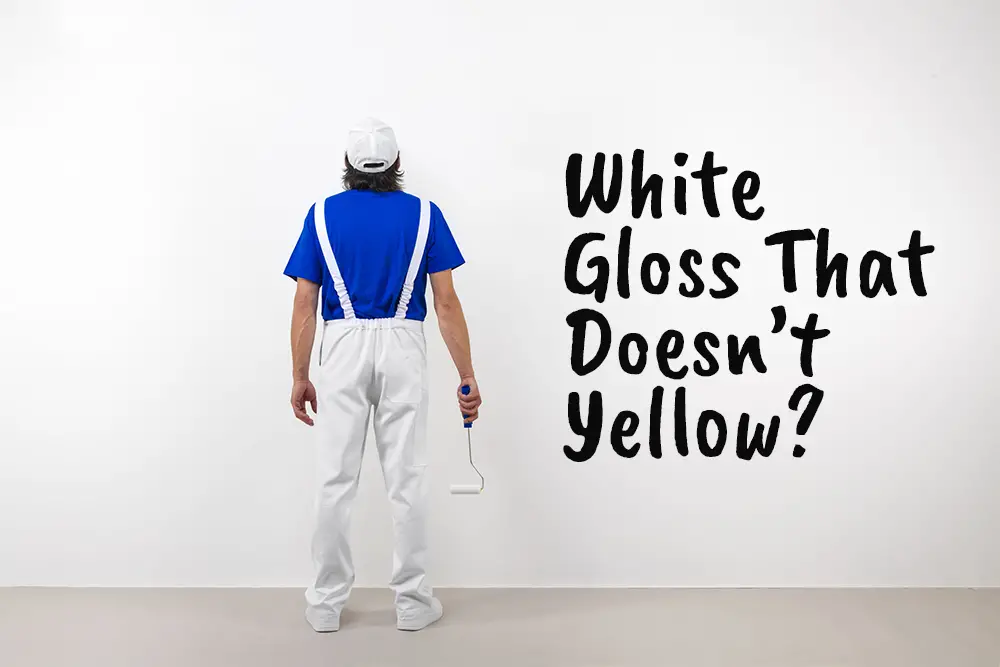A real problem with applying a new coat of paint to an interior, surface or object is often the gloss paint can yellow and discolour over time. So what’s the best white gloss paint that doesn’t yellow? or the best gloss paint to stay white?
While this issue is a common problem encountered by painting novices, finding a solution if you are concerned about paintwork turning yellow is all about the type of paint base to use so you can reduce the possibility of the problem occurring before applying any paint.
Subscribe to our newsletter as we release new site features and publish new home DIY projects.
Gloss paint is one of the most popular paint finishes available in the UK, often sold in a range of colour choices with white gloss being the most popular for its fresh appealing look.
It is used by many for home improvements and decoration due to its hardwearing characteristics and great paint coverage. While it’s true, gloss paint comes with some great benefits the most common drawback is often the gloss paint easily yellows with time, causing a once-perfect white finish to turn dull and off colour.
The yellowing of gloss paint is such a big issue for many homeowners because of the unappealing shade that develops over time causing the once fresh and bright finish to turn dull and creates an almost dirty look to the surface. So, it’s no wonder that people looking for white gloss paint that doesn’t yellow has increased.
This problem has been recognised by established paint brands such as Dulux, Johnstone’s and Crown as they focus their attention on producing the perfect non-yellowing gloss paint to give homeowners a viable solution to eliminate the problem. As they try to develop the best gloss paint to stay white.
Used for so many surfaces, gloss paint is extremely popular for its versatility and is often applied to both woodwork and metal surfaces. You will notice gloss paint applied on both interior and exterior doors, window frames, skirting boards and furniture for its unique high sheen and reflective finish.
Why Does Gloss Paint Go Yellow?

To understand why gloss paint goes yellow, it’s important to first understand the two types of gloss paint available within the UK. Gloss paint, sold in either oil-based or water-based formulas – with oil-based gloss paint the most popular choice among homeowners.
However, with the introduction of water-based gloss paint – is proving to be in high demand for many homeowners due to its unique characteristics over traditional oil-based solvent gloss paint. Could this be the solution for white gloss paint that doesn’t yellow?
Oil-based paint is more toxic due to the mid-high VOC contents, also known as Volatile Organic Compounds – it’s the number of toxic components found within the paint formula. VOC are harmful and toxic to both the environment and people but they help to produce a long-lasting bright finish for gloss paint.
VOC’s are substances which release vapour at room temperatures. VOC’s are added to some paints to aid drying times and they do this by vapourising the liquids in the paint to get to a hardened finish in the shortest time possible. The solvent vapours produced by VOC’s in the paint can be harmful if proper ventilation isn’t available – especially if used indoors. Exposure to high VOC paint should be limited.
In 2010 came the introduction of the European Union’s Industrial Emissions Directive (IED –Directive 2010/75/EU) which puts emission limits on Volatile Organic Compounds (VOC) contents within industrial activities. This directive is then enacted in the UK by the Environmental Permitting (England and Wales) Regulations 2010 SI 675. The result is a restriction of VOC contents within the paint industry.
So what are these limits?
| Product Type | Base | VOC’s Grams Per Litre |
| Interior matt walls and ceilings (Gloss ≤25@60°) | Oil-Based | 30 |
| Interior matt walls and ceilings (Gloss ≤25@60°) | Water-Based | 30 |
| Interior glossy walls and ceilings (Gloss >25@60°) | Oil-Based | 100 |
| Interior glossy walls and ceilings (Gloss >25@60°) | Water-Based | 100 |
| Interior/exterior trim paints for wood and metal | Oil-Based | 130 |
| Interior/exterior trim paints for wood and metal | Water-Based | 300 |
| Interior/exterior trim varnishes and wood stains | Oil-Based | 130 |
| Interior/exterior trim varnishes and wood stains | Water-Based | 400 |
With the new legislation being introduced in 2010 painting manufacturers sought to find a solution to the new limits of solvent regulations in the UK. This prompted manufacturers to replace it with an increase of drying oil components to aid in the finish of gloss paint.
Unfortunately, an unknown side effect of the introduction of additional drying oil components resulted. With previous well-established paint mixtures boasting long-lasting white gloss finish the new mixtures failed to provide the same quality that many homeowners came to expect from their paint finish.
The result was the yellowing of paint over time, with some gloss paints yellowing in a matter of months or even weeks after application. Not ideal when looking for a long-lasting white finish and a white gloss paint that doesn’t yellow.
The issue has affected all oil-based gloss paint manufacturers within the UK. Where the solution has been the development of more robust water-based gloss paints with low odour and low VOC contents that don’t yellow.
The Solution is a Water-Based Non-Yellowing Gloss Paint
While it’s personal preference when choosing what type of paint base to use, either oil-based or water-based. For the best results and to avoid yellowing of gloss paint the solution is a high-quality water-based paint, A Water-based gloss paint will not yellow over time.
It’s not definite that all oil-based gloss paints will yellow in time, it’s a lot of work to put in for that to happen down the line, be aware that even guaranteed non-yellowing oil-based paints can often fail in time.
The best way is to avoid the possibility of yellowing gloss is by choosing a water-based gloss and with the ongoing development of WB paints, new products are coming to market that offers better durability and more hard-wearing capabilities that can often rival those of oil-based solvents.
Water-based paints benefit from reduced drying times compared to oil-based paints and can often be dry to touch within an hour or two. While they often need multiple coats to be fully opaque the reduced drying time means the task of re-application does not have to be a lengthy process.
You can expect water-based paints to be water-soluble and easy to clean making the painting process smooth and non-troublesome but the paint will become water-resistant when dry. Containing microscopic plastic particles of binder such as acrylic, PVA or alkyd it is less harmful to the environment than oil-based solvents. but be aware that WB paints do contain some VOC’s which can release during the drying process so plenty of ventilation is always recommended.
Why Does White Gloss Go Yellow?
The Problem first started to occur in 2010 due to the introduction of the European Union’s Industrial Emissions Directive IED, which puts emission limits on Volatile Organic Compounds (VOC) contents within paint. This directive is then enacted in the UK. The result is a restriction of VOC contents within the paint industry. The limiting of VOC contents had a side effect of white gloss going yellow.
How Do You Keep White Paint From Turning Yellow?
Allow light either natural or artifical to hit the surface areas painted in gloss. Light slows down the yellowing process of white gloss paint that can often be seen behind furniture where little or no light reaches.
Does Water-Based Gloss Go Yellow?
Water-based gloss is the perfect choice for interiors as it tends not to yellow or dull over time especially when you compare it to more oil-based paints that yellow over time.
Does White Oil-Based Paint Yellow?
While oil-based paints have noteable benefits such as being hard-wearing and resistant to knocks, they do suffer from the yellowing process that occurs over time.
How Do You Brighten White Gloss Paint?
Apart from applying a fresh coat of paint, you can wipe down and clean your white gloss paint surfaces with a mixture of bleach and water to help reduce the possibility of the paint yellowing.
Summary
If you’re looking for a white gloss paint that doesn’t yellow then your best option is a water-based gloss paint. They don’t yellow over time like oil-based solvent gloss paint. While in the past, traditional gloss paint was perfect for a white gloss paint that doesn’t yellow, due to the EU directive that limits VOC that used to be integral to the non-yellowing process being implemented. Water-based non-yellowing gloss paint is where you will find the most success.
Related pages where you can find the best gloss paint to stay white for different applications and objects:
Pinterest Image:


Who makes the best water based gloss paint
I am looking for recommendations as to which type of gloss paint to use m oil based or water based
What are you painting Judith?
Do you have a preference? water-based is faster drying and less potent. Oil based is harder wearing most of the time.